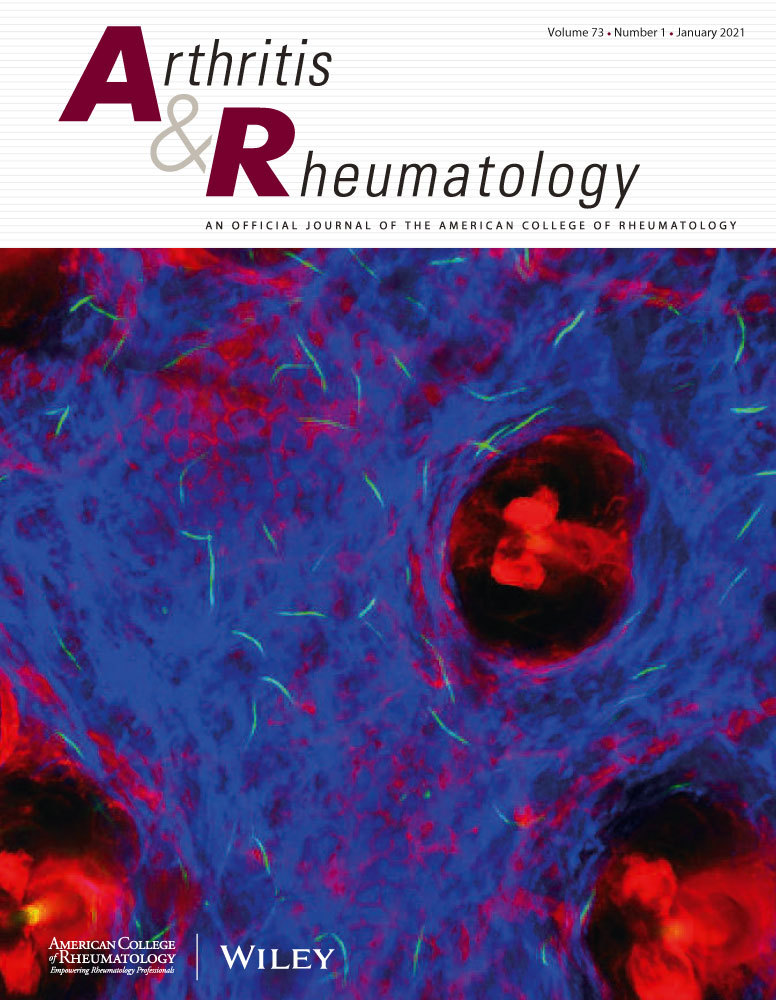HLA class I-downregulated senescent epidermal basal cells orchestrate skin pathology in cutaneous lupus erythematosus.
IF 10.9
1区 医学
Q1 RHEUMATOLOGY
引用次数: 0
Abstract
OBJECTIVE To investigate the role of senescent epidermal basal cells in cutaneous lupus erythematosus (CLE) pathogenesis using skin samples from patients with CLE and a mouse model of systemic lupus erythematosus (SLE). METHODS Cellular senescence profiling utilized datasets from the NCBI Gene Expression Omnibus database and Accelerating Medicines Partnership® (AMP®) Phase 1-Metro. Gene array data from GSE184989 (CLE: n = 68, control: n = 4), single-cell RNA sequencing data from GSE186476 (CLE: n = 7, control: n = 14), and AMP® Phase 1-Metro (SLE: n = 17) were utilized. In vitro experiments further examined the expression of p21WAF1/CIP1, type I interferon (IFN), human leukocyte antigen class I (HLA-I), and epidermal growth factor receptor (EGFR) signalling. Pharmacological clearance of senescent cells was performed using the senolytic drug fisetin in the SLE mouse model. RESULTS p21WAF1/CIP1-high senescent epidermal basal cells in patients with CLE exhibit high type I IFN expression. These cells enhance IFN signalling in surrounding normal epidermal basal cells, leading to increased HLA-I expression. In contrast, senescent epidermal cells upregulate EGFR signalling, which downregulates HLA-I expression, allowing them to evade immune surveillance. This heterogeneity of HLA-I expression promotes CD8-positive T-mediated toxicity against normal epidermal basal cells, resulting in their apoptosis. Pharmacological clearance of senescent epidermal basal cells improved SLE-like skin lesions. CONCLUSION Senescent cells create a microenvironment that directs cytotoxic T-cell-mediated responses against normal epidermis in CLE, contributing to disease pathology. Targeting senescent cells and their signalling pathways may offer novel therapeutic strategies for CLE and SLE skin lesions.HLA - 1类下调的衰老表皮基底细胞协调皮肤红斑狼疮的皮肤病理。
目的利用皮肤红斑狼疮(CLE)患者皮肤样本和系统性红斑狼疮(SLE)小鼠模型,探讨衰老表皮基底细胞在CLE发病机制中的作用。方法细胞衰老分析利用NCBI基因表达综合数据库和加速药物合作伙伴关系(AMP) 1期metro的数据集。基因阵列数据来自GSE184989 (CLE: n = 68,对照组:n = 4),单细胞RNA测序数据来自GSE186476 (CLE: n = 7,对照组:n = 14)和AMP®1期metro (SLE: n = 17)。体外实验进一步检测了p21WAF1/CIP1、I型干扰素(IFN)、人白细胞抗原I类(HLA-I)和表皮生长因子受体(EGFR)信号的表达。在SLE小鼠模型中使用抗衰老药物非西汀对衰老细胞进行药理学清除。结果CLE患者的衰老表皮基底细胞中有较高的I型IFN表达。这些细胞增强周围正常表皮基底细胞中的IFN信号,导致hla - 1表达增加。相反,衰老的表皮细胞上调EGFR信号,从而下调hla - 1的表达,从而使它们逃避免疫监视。hla - 1表达的异质性促进了cd8阳性t介导的对正常表皮基底细胞的毒性,导致其凋亡。衰老表皮基底细胞的药理清除可改善sle样皮肤病变。结论:在CLE中,衰老细胞创造了一个微环境,指导细胞毒性t细胞介导的针对正常表皮的反应,促进了疾病病理。靶向衰老细胞及其信号通路可能为CLE和SLE皮肤病变提供新的治疗策略。
本文章由计算机程序翻译,如有差异,请以英文原文为准。
求助全文
约1分钟内获得全文
求助全文
来源期刊

Arthritis & Rheumatology
RHEUMATOLOGY-
CiteScore
20.90
自引率
3.00%
发文量
371
期刊介绍:
Arthritis & Rheumatology is the official journal of the American College of Rheumatology and focuses on the natural history, pathophysiology, treatment, and outcome of rheumatic diseases. It is a peer-reviewed publication that aims to provide the highest quality basic and clinical research in this field. The journal covers a wide range of investigative areas and also includes review articles, editorials, and educational material for researchers and clinicians. Being recognized as a leading research journal in rheumatology, Arthritis & Rheumatology serves the global community of rheumatology investigators and clinicians.
 求助内容:
求助内容: 应助结果提醒方式:
应助结果提醒方式:


